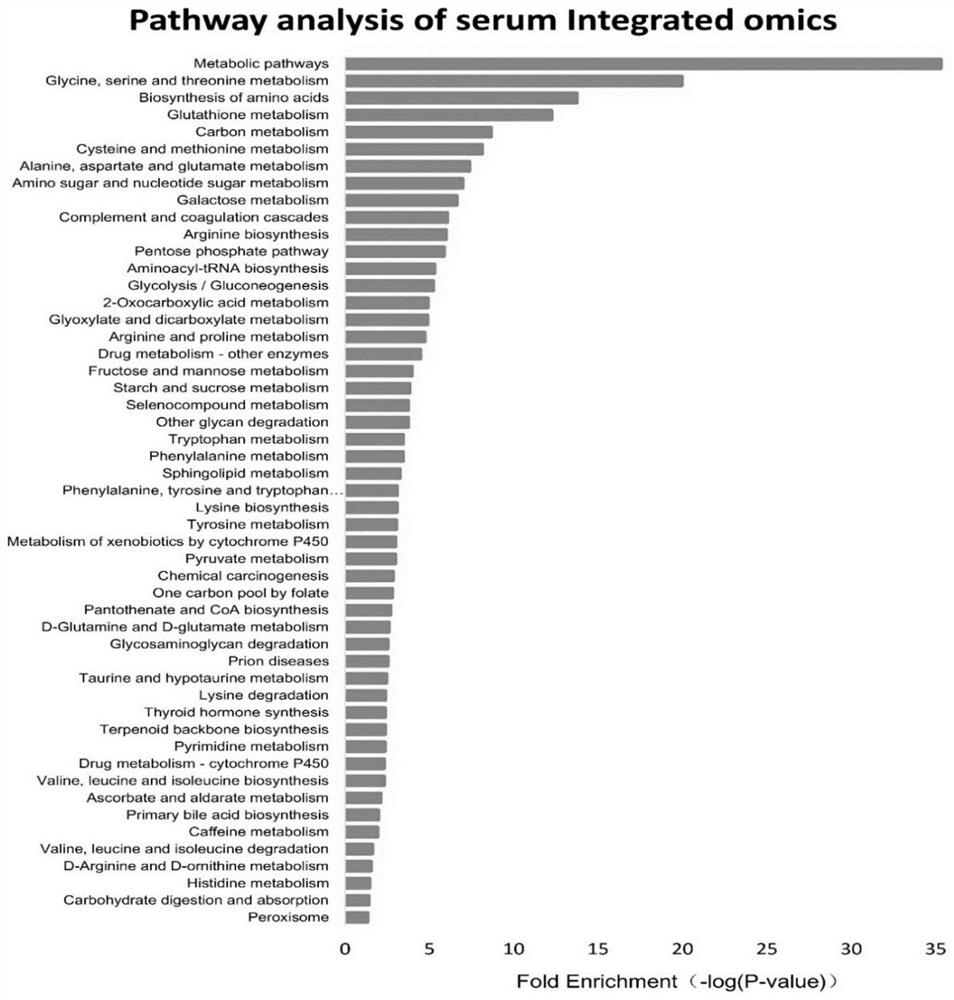Biomarker for evaluating zinc nutrition state of individual and application thereof
A zinc nutrition and individual technology, applied in the field of biomarkers, can solve the problems of lack of sensitive and specific indicators
- Summary
- Abstract
- Description
- Claims
- Application Information
AI Technical Summary
Problems solved by technology
Method used
Image
Examples
Embodiment 1
[0041] Example 1 Zinc deficiency animal model establishment and multi-omics experiment screening candidate biomarkers
[0042] 1. Feeding and sample collection of zinc-deficient rats:
[0043] 48 male Wistar rats with a body weight of 60-80g at the age of 3 weeks were randomly divided into 3 groups after being adaptively fed for 7 days in a separate metabolic cage: control group (15 rats): normal zinc diet (zinc content is 30mg / ml) Pure synthetic feed); Zinc deficiency group (15): low zinc diet (pure synthetic feed with zinc content of 10mg / ml); pair feeding group (15): normal zinc diet (pure synthetic feed with zinc content of 30mg / ml) feed), the feed intake was the same as that of the low zinc group. All rats were continuously fed for 4-6 weeks. Dynamic monitoring of basic indicators such as rat body weight, food intake, and urine output, and energy metabolism detection of energy and meal consumption.
[0044] 2. Relevant index detection:
[0045] After the experiment wa...
Embodiment 2
[0094] Example 2 Validation of Zinc Deficiency Population of Zinc Deficiency Biomarkers
[0095] Through two zinc deficiency susceptible populations: children aged 4-6 and low-income manual laborers (age 45-58), grouped by serum zinc, the candidate markers screened in animal experiments were verified to determine the biomarkers of zinc deficiency in the population. A randomized controlled zinc supplementation intervention trial in zinc deficient populations to further identify biomarkers of zinc deficiency in the population. Expand the sample size, conduct whole-population experiments, quantitatively detect the concentration of biomarkers, and determine the normal range of biomarkers.
[0096] The ultimate goal expected to be achieved is to establish a standard method for the nutritional assessment of zinc deficiency.
[0097] The study recruited children (4-6 years old) as the children group and low-income manual labor middle-aged people (40-58 years old) as the middle-aged ...
Embodiment 3
[0117] Example 3 Zinc Supplementation Intervention Experiment for Zinc Deficient Crowds
[0118] In the middle-aged group, people with low zinc levels were selected for zinc supplementation intervention experiment. This study was a randomized double-blind controlled trial. The experiment lasted for 2 weeks. The researchers drew fasting venous blood from the participants in the first week and the second week respectively. Serum zinc and biomarker concentrations were detected to verify the sensitivity and specificity of the biomarkers. Throughout the experiment, dietary questionnaires were administered to the population to calculate dietary zinc intake. At the same time, other interfering factors were excluded, and the correlation analysis was used to evaluate the changes of biomarkers, serum zinc levels and zinc intake levels, as well as the diagnostic ability of ROC curve analysis biomarkers.
[0119]Experimental process: Zinc supplementation intervention experiment recruited...
PUM
 Login to View More
Login to View More Abstract
Description
Claims
Application Information
 Login to View More
Login to View More - R&D
- Intellectual Property
- Life Sciences
- Materials
- Tech Scout
- Unparalleled Data Quality
- Higher Quality Content
- 60% Fewer Hallucinations
Browse by: Latest US Patents, China's latest patents, Technical Efficacy Thesaurus, Application Domain, Technology Topic, Popular Technical Reports.
© 2025 PatSnap. All rights reserved.Legal|Privacy policy|Modern Slavery Act Transparency Statement|Sitemap|About US| Contact US: help@patsnap.com



